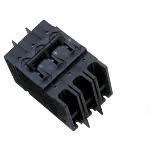
Circuit breakers play an important role in the electrical systems of airplanes. A typical airplane has hundreds if not thousands of electrical devices. With circuit breakers, a sudden surge of current won’t damage these devices. What is a circuit breaker exactly, and how does it protect devices from damage?
Overview of Circuit Breakers
A circuit breaker is an electrical safety device that’s designed to protect devices on an electrical circuit from overcurrent.
Overcurrent is an electrical event that involves too much electricity or current attempting to flow through a given circuit. Devices can only handle so much current. If they are exposed to an excessively high current, they may sustain damage or even catch fire, the latter of which is a serious safety hazard. Circuit breakers are designed to protect devices from overcurrent.
How Circuit Breakers Work
Circuit breakers have sensors to detect unusual current flow. If the current running through a circuit breaker exceeds that for which it’s rated, the circuit breaker will trip.
Depending on the specific type of circuit breaker, it may have a metallic strip that heats up and bends, or it may have an electromagnetic that responds to the excess current. Regardless, once the circuit breaker trips, current will no longer flow through it. The circuit will become open, meaning the devices on the circuit will no longer receive power.
Circuit breakers must typically be reset after tripping. Resetting a circuit breaker usually involves nothing more than flipping a switch. Upon flipping the switch, the breaker’s contacts will become aligned with the connecting wires, allowing current to flow through it once again. With that said, you should always identify and fix the electrical fault that caused the breaker to trip so that it doesn’t happen again.
Circuit Breakers vs Fuses
Circuit breakers and fuses aren’t the same. They are both designed to protect devices on a circuit from overcurrent, but circuit breakers are reusable whereas fuses are not.
When a circuit breaker experiences an overcurrent event, you can reset it. Neither the breaker nor any of the devices on the circuit should become damaged. When a fuse experiences an overcurrent event, on the other hand, you’ll typically need to replace it.
Fuses contain filaments that burn or break during an overcurrent event. They only allow a certain amount of electricity to flow through them. Overcurrent events will expose fuses to an excessive amount of electricity. A thin filament in the center of them will break or burn, at which the circuit will become open. The only way to restore power to the devices on the circuit is to replace or repair the fuse.



